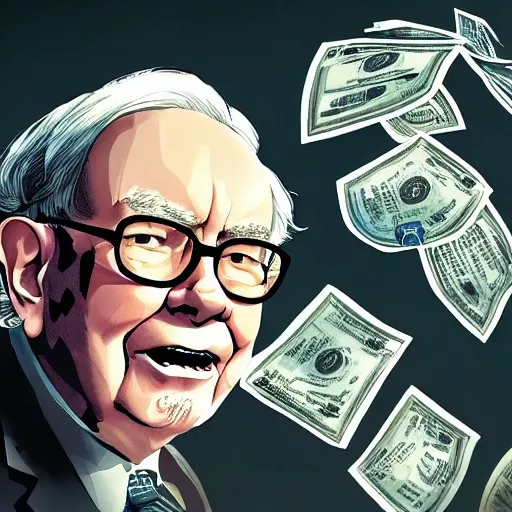This fanpage is not officially affiliated with Berkshire Hathaway: Disclaimer

We exploree the 2023 banking crisis, its effect on regional banks, and the potential role Berkshire Hathaway might play in stabilizing the financial system. Drawing on historic references, the article examines the company's involvement in the 2008 financial crisis and its stakes in Bank of America and American Express. The analysis considers possible opportunities for Berkshire Hathaway to invest in struggling regional banks and the broader economic context, including the impact on the commercial real estate market and property development. The article concludes with a discussion on the likelihood of Berkshire Hathaway making a move on regional banks and the potential consequences of such a move.
Introduction
The 2023 global banking crisis emerged in March 2023, sending shockwaves through the financial world. With central banks intermediating rising interest rates after mid-2022 and bank capital reserves declining due to falling bond prices, several large US banks, including Silicon Valley Bank and Silvergate Bank, collapsed. The crisis also led to the liquidation of Signature Bank under financial distress. In the past, Berkshire Hathaway has played a significant role in stabilizing the financial system during crises, making its potential involvement a topic of interest for shareholders and industry observers alike.
In this article, we will explore the factors leading to the collapse of Silicon Valley Bank, Silvergate Bank, and Signature Bank, as well as the U.S. Federal response to the crisis. We will also examine the role of Berkshire Hathaway in the 2008 financial crisis and analyze the potential opportunities for the company in the current banking crisis.
The Collapse of Silicon Valley Bank, Silvergate Bank, and Signature Bank
Silicon Valley Bank
Founded in 1983 and headquartered in Santa Clara, California, Silicon Valley Bank primarily served the tech industry and venture capital-backed companies. With $209 billion in assets at the end of 2022, it ranked as the 16th largest bank in the U.S. The bank heavily invested in long-term Treasury bonds, which were severely affected by rising interest rates. A bank run on March 8-9, 2023, resulted in the withdrawal of $42 billion. Consequently, the California Department of Financial Protection and Innovation seized the bank on March 10, 2023. The FDIC established a deposit insurance national bank, and First Citizens BancShares acquired SVB's commercial banking business.
Silvergate Bank
Silvergate Bank, founded in 1988, focused on the cryptocurrency market and expanded its assets to $1.9 billion in 2017. By the fourth quarter of 2022, 90% of Silvergate's deposits were related to cryptocurrencies. However, the bank faced requests to withdraw upwards of $8 billion in deposits following the bankruptcy of FTX, a large cryptocurrency exchange. Silvergate realized a loss of $718 million on withdrawal-related asset sales in Q4 2022, and the bank announced voluntary liquidation on March 8, 2023.
Signature Bank
Established in 2001 and based in New York City, Signature Bank catered to small businesses and the multifamily residential rental housing market. The bank expanded into the cryptocurrency industry from 2018, growing its deposits to $104 billion by August 2022. With clients that included large cryptocurrency exchange operators and the development of its proprietary payment network, Signet, the bank was heavily invested in the crypto space. However, when crypto prices dropped in 2022, depositors withdrew billions of dollars, leading to a bank run on March 10, 2023, and a stock decline of 23%. Regulators closed Signature Bank on March 12, 2023, placing it under FDIC receivership. New York Community Bank agreed to purchase around $38.4 billion of Signature's assets.
In response to the collapses of these major banks, multiple banking regulators provided extraordinary liquidity to prevent a further crisis. The Federal Reserve's discount window liquidity facility experienced approximately $150 billion in borrowing by March 16, and the Fed created the Bank Term Funding Program (BTFP) to offer loans to banks and other eligible institutions.
In the following sections, we will delve into Berkshire Hathaway's role in the 2008 financial crisis and explore the potential opportunities for the company amid the current banking crisis.
The Role of Berkshire Hathaway in the 2008 Financial Crisis
During the 2008 financial crisis, Warren Buffett's Berkshire Hathaway provided critical funding to several major institutions, including Goldman Sachs, General Electric, and others. These investments not only helped stabilize the financial system but also proved to be lucrative deals for Berkshire Hathaway.
For example, Berkshire Hathaway made over $3 billion in profit from a $5 billion investment in Goldman Sachs. Similarly, the company more than doubled its money on paper after investing $5 billion in Bank of America in 2011. Buffett's backing played a significant role in preventing further bank failures and restoring faith in the financial system. ↗
At the time, Berkshire Hathaway's investments were considered risky, but Buffett's confidence in the long-term prospects of these institutions helped turn the tide of the crisis. The success of these deals showcased Buffett's ability to identify opportunities in distressed markets and capitalize on them.
Berkshire Hathaway's Current Stakes in Bank of America and American Express
In recent months, the combined value of Berkshire Hathaway's stakes in Bank of America and American Express has dropped by $9 billion. This decline has raised concerns about the company's exposure to the financial sector amid the current banking crisis.
Despite this setback, Berkshire Hathaway's history of successful investments in the financial industry during times of crisis suggests that the company may be well-positioned to take advantage of potential opportunities presented by the current turmoil. As regional banks face mounting pressure, Buffett's experience and the company's significant financial resources may enable Berkshire Hathaway to play a stabilizing role in the market once again.
In the next sections, we will explore the potential opportunities for Berkshire Hathaway in the current banking crisis and analyze the broader economic context, including the impact of the crisis on the commercial real estate and property development markets.
Potential Opportunities for Berkshire Hathaway in the Current Banking Crisis
While there are similarities between the 2008 financial crisis and the current banking crisis, there are also important differences that may affect the nature of Berkshire Hathaway's potential involvement this time around. In 2008, many large institutions were in need of capital injections, whereas the present crisis primarily affects regional banks, which are smaller in size.
One potential opportunity for Berkshire Hathaway in the current crisis could be investing in struggling regional banks. Although the company may not be able to secure deals as lucrative as those it made during the 2008 crisis, there is still potential for profit, especially if Buffett's backing helps restore confidence in the financial system.
For instance, US banks have provided up to $30 billion to support First Republic, a regional bank that has been impacted by the crisis. Berkshire Hathaway could explore similar deals with other regional banks to help stabilize the industry.
It is important to note, however, that the profitability of such deals may be lower this time due to the smaller size of the lenders involved and the availability of more funding sources, including government-backed programs like the Bank Term Funding Program (BTFP). Nonetheless, the potential for stabilizing the financial system and earning profits through strategic investments remains a viable opportunity for Berkshire Hathaway.
Historic References and Broader Economic Context
Regional banks play a crucial role in the U.S. economy, particularly in providing loans to small businesses and supporting the commercial real estate sector. In fact, US small banks account for 70% of total lending in the commercial real estate sector. The current banking crisis is putting significant pressure on regional banks, which has far-reaching implications for the economy.
For instance, the crisis is impacting the commercial real estate market and property development, as the availability of credit becomes more constrained. This could lead to a slowdown in new construction projects and a decline in property values, further exacerbating the crisis.
Historically, government interventions and support from large investors like Berkshire Hathaway have been instrumental in stabilizing the financial system during crises. In the current situation, President Biden has assured the stability of the banking system while denying a bailout, and the Federal Reserve is considering pausing or halting rate hikes to alleviate pressure on banks.
In this context, Berkshire Hathaway's involvement in supporting regional banks could be a vital factor in preventing further bank failures and restoring faith in the financial system. As in the past, the company's backing and financial resources could serve as a stabilizing force in the market, potentially generating long-term benefits for both the economy and Berkshire Hathaway's shareholders.
In the final section, we will conclude by analyzing the likelihood of Berkshire Hathaway making a move on regional banks and the potential impact of such a move on the banking industry and overall financial stability.
Conclusion: Will Berkshire Hathaway Make a Move on Regional Banks?
The 2023 banking crisis has put significant pressure on regional banks in the United States, with potential consequences for the broader economy, including the commercial real estate market and property development. Given Berkshire Hathaway's history of providing critical funding during financial crises, there is reason to believe that the company may once again play a key role in stabilizing the financial system by supporting struggling regional banks.
However, the current crisis presents a different landscape than the 2008 financial crisis. The focus is now on smaller regional banks rather than large institutions, and there are more available funding sources, such as government-backed programs. This means that while Berkshire Hathaway may still see potential opportunities in investing in regional banks, the deals may not be as lucrative as those made during the 2008 crisis.
Despite these differences, Berkshire Hathaway's vast financial resources and Warren Buffett's experience in navigating distressed markets make the company well-suited to help restore confidence in the financial system. By selectively investing in regional banks, Berkshire Hathaway could not only prevent further bank failures but also generate long-term benefits for both the economy and the company's shareholders.
In conclusion, while it is impossible to predict with certainty whether Berkshire Hathaway will make a move on regional banks amid the 2023 banking crisis, the company's history and the potential opportunities for stabilizing the financial system suggest that it is a possibility worth considering. If Berkshire Hathaway does choose to invest in struggling regional banks, such a move could have a significant impact on the banking industry and overall financial stability, similar to the company's involvement during the 2008 financial crisis.
References. The article is based on the following latest ressources on the topic:







